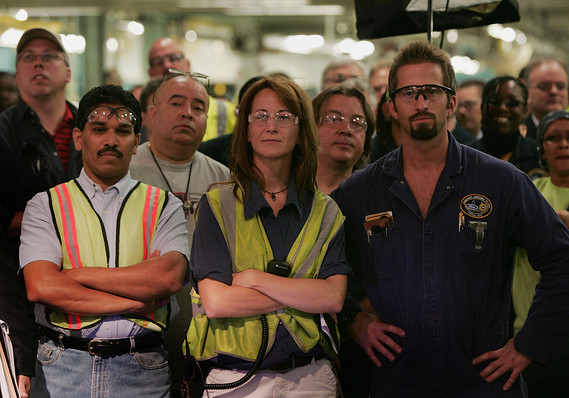 Scott Olson/Getty Images
Scott Olson/Getty Images President Donald Trump enters an election year with a strong economy.
Economic growth has averaged 2.6%—the Bush and Obama presidencies together posted less than 2%.
Wages are advancing more rapidly than during the Obama years. On a percentage basis those are rising more for workers in the bottom quartile of earners than the top, and gains for minority groups have been particularly strong. The president’s apprenticeship program is opening new high-paying opportunities across the economy for non-college bound youth.
Women are now half of all non-farm employees. In 2018, women opened businesses at nearly twice the pace as during the prior six years, and college women are shifting in greater numbers to once male-dominated higher-paying college majors. Those trends should do a great deal to substantially reduce the gender pay gap.
A recent Economist/You Gov survey found 60% of Americans are happy or very happy with their jobs, only 13% said the reverse, and 46% say they are better off today than they were four years ago compared with 32% who say they were better off four years ago.
No recession
Economists and the media have made a lot of Trump’s trade wars and claim manufacturing is in a recession but that sector—normalizing for the temporary disruptions imposed by the GM GM, -2.84% strike—has added jobs 31 of the last 33 months.
Manufacturers don’t add workers if they expect to make less stuff!
Retailers and other businesses are sourcing less from China and somewhat more from U.S. factories and from Mexico and other Asian locations—nations that don’t throw up barriers to U.S. exports or steal our technology with the zeal of Beijing’s subsidized enterprises.
The Midwest lost jobs in agriculture and in some manufacturing sectors in the face of Chinese retaliation. Central to the phase one agreement, Beijing promises to boost imports of U.S. agricultural and other goods by $200 billion. This may ameliorate the above mentioned problems but the value of that promise remains to be seen.
Falling currencies helped pull China’s farm imports from Argentina and Brazil, likely as much as Beijing’s tariffs, and reversing those sourcing patterns will prove a challenge for China. And changing other entrenched patterns of behavior among Chinese businesses and consumers will prove equally difficult.
However, a robust jobs market is opening new opportunities in key states like Wisconsin and Iowa. As some farms and factories affected by Chinese sanctions shed workers, other employers are crowding the gates to recruit them as they leave.
In the Trump economy, a Midwesterner would have to stay in bed not to find a decent job.
Challenges ahead
Going forward, the impeachment trial should be behind the president by spring and then he should challenge the Congress on unfinished business. Addressing problems plaguing the middle class will be critical to his re-election prospects and a successful second term.
Since 1999, median household income, adjusted for inflation, has hardly changed. However, prices for many items most middle class folks consider essential—health care, automobiles, housing and college tuition — have risen much more rapidly than nominal family incomes.
Americans are borrowing excessively to finance automobiles and taking equity out of their homes for other expenses and to retire other debt.
Higher education debt is causing young people to delay marriage, children and home purchases, and only far-reaching debt relief forgiveness can get us out of that box.
Without immigration reform, the country faces acute labor shortages, and the president has advocated moving towards a skills-based system — akin to the Canadian and Australian regimes.
To contain China’s mercantilism and increasingly aggressive foreign policy, we need allies and their cooperation.
Getting the U.S.-Mexico-Canada Free Trade Agreement (USMCA) through Congress is a relatively easy lift — at least Trump and Speaker Nancy Pelosi essentially agree on its overall benefits. However, the president and his trade representative must back off confrontation to re-engage our allies in Asia and Europe by reopening discussions for U.S. membership in the Trans-Pacific Partnership and reforms to modernize the World Trade Organization.
The latter is a tough but necessary course adjustment for Trump but the hard left that dominates the Democratic party is decidedly isolationist and protectionist. Americans generally see the threat posed by China but most want more cooperation with our friends.
That’s the pivot Trump must make to keep robust growth going and get an A from this professor.
div > iframe { width: 100% !important; min-width: 300px; max-width: 800px; } ]]>










Add Comment